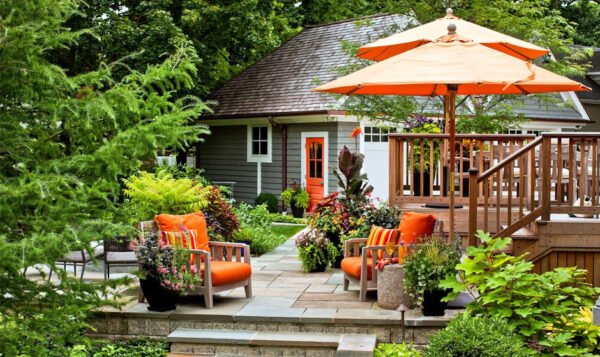6 Home Improvement Tips to Maintain a Healthy Environment

Long Island experiences a broad range of weather conditions throughout the year, from sweltering summers to freezing winters. Such fluctuations can greatly affect the indoor environment of homes, making it crucial for homeowners to adapt their spaces to maintain a comfortable and healthy living atmosphere. Ensuring your home can effectively handle these changes is essential not only for comfort but also for the health of its occupants.
Regular home improvements tailored to combat the adverse effects of weather can significantly enhance the quality of life. These improvements not only contribute to a healthier home environment but also help in reducing energy consumption and extending the lifespan of the home’s infrastructure.
Let’s discuss them below:
1. Enhancing Heating, Cooling, and Plumbing Systems
Maintaining and upgrading heating, cooling, and plumbing systems are fundamental to keeping a healthy home environment, especially in a place like Long Island, where the weather can change drastically. Efficient systems ensure that homes remain warm during the cold winters and cool during the hot summers, all while managing humidity levels to prevent issues such as mold and mildew. Furthermore, well-maintained plumbing systems prevent leaks and water damage, which can lead to health hazards if left unchecked.
For efficient service and rapid response to heating, cooling, and plumbing needs, homeowners can rely on a Long Island home services company. Varsity Home Service, for instance, excels in providing swift and reliable solutions, striving to offer same-day service whenever possible. This commitment ensures that any disruptions to your home’s comfort and safety are promptly addressed, minimizing any potential for discomfort or health risks.
2. Improving Indoor Air Quality
Indoor air quality is a critical component of a healthy home. Pollutants such as dust, pollen, and other allergens can accumulate inside homes, particularly during seasons when windows are kept closed. Improving ventilation and regularly replacing HVAC filters are effective ways to reduce these indoor air pollutants. Additionally, investing in air purifiers can further cleanse the air, making the environment safer for those with allergies or respiratory issues.
Another significant step in maintaining good indoor air quality is ensuring your home’s HVAC system is up-to-date and properly serviced. Regular maintenance checks can prevent the circulation of contaminants and ensure the system is running as efficiently as possible. These actions not only improve the air quality but also enhance the overall energy efficiency of your home, reducing both costs and environmental impact.
3. Upgrading Insulation and Sealing Leaks
Proper insulation plays a pivotal role in maintaining a healthy indoor environment by stabilizing indoor temperatures and reducing the infiltration of outdoor allergens and pollutants. Effective insulation helps keep the warm air in during the winter and out during the summer, aiding in energy conservation and providing comfort year-round. Additionally, it prevents moisture from seeping into walls, which can lead to mold growth and deteriorate air quality.
Sealing leaks around windows, doors, and other openings is another crucial improvement. This not only prevents drafts and heat loss but also blocks dust and pests from entering the home. Homeowners should regularly inspect seals and weather stripping and replace them as necessary to ensure their homes remain airtight and energy-efficient. These improvements not only contribute to a healthier living environment but also help in significantly lowering energy bills.
4. Using Non-Toxic and Natural Materials
When undertaking home renovations or improvements, selecting non-toxic and natural materials can make a significant difference in maintaining a healthy indoor environment. Traditional building materials, paints, and finishes often contain volatile organic compounds (VOCs) and other chemicals that can off-gas into the home, deteriorating indoor air quality and posing health risks. Opting for low-VOC or VOC-free paints, as well as natural wood or bamboo flooring, can reduce exposure to harmful chemicals.
Additionally, when choosing furniture or cabinetry, it’s beneficial to seek out items made from natural materials that do not emit harmful gases. Materials such as organic cotton, wool, and naturally tanned leather can also contribute to healthier indoor environments, supporting a non-toxic lifestyle. These choices not only ensure a safer living space but also contribute to a more sustainable home, aligning with environmentally conscious living principles.
5. Smart Home Technologies for Health Monitoring
The integration of smart home technologies offers significant advantages in managing and improving home health. Smart thermostats, for instance, can automatically adjust the indoor temperature for optimal comfort and energy efficiency. They can also monitor humidity levels, which is crucial in preventing mold growth and maintaining a healthy environment. Additionally, smart detectors can monitor air quality, alerting homeowners to the presence of carbon monoxide or other harmful substances.
Further, smart home systems can be programmed to optimize lighting, heating, and air conditioning based on the time of day and occupancy, promoting a healthier lifestyle through improved sleep patterns and personal comfort. Such technologies not only enhance living conditions but also offer the convenience of remote management through smartphones or other devices, allowing homeowners to maintain an ideal home environment from anywhere.
6. Regular Maintenance and Pest Control
Regular maintenance is essential in preventing minor issues from becoming major problems that can affect the home’s environment and the health of its occupants. Scheduling regular inspections for HVAC systems, roofing, and plumbing can help catch issues like leaks or inefficiencies early before they lead to larger, more costly repairs. Preventative maintenance ensures that home systems are running efficiently and healthily, keeping the living environment in top condition.
Incorporating integrated pest management (IPM) strategies is another vital aspect of maintaining a healthy home. Pests can not only cause structural damage but also carry diseases that can affect human health. IPM focuses on long-term prevention and uses comprehensive information on the life cycles of pests and their interaction with the environment. This approach minimizes the use of harmful chemicals, instead relying on more natural solutions and barriers to keep pests at bay, thereby maintaining a healthier living environment.
Conclusion
Implementing these six home improvement tips can significantly contribute to creating and maintaining a healthier living environment. From enhancing heating, cooling, and plumbing systems to upgrading to non-toxic materials and utilizing smart home technologies, each strategy plays a crucial role in promoting health and well-being within the home. Long Island residents, facing distinct seasonal changes, can particularly benefit from these improvements to ensure their homes remain safe, comfortable, and energy-efficient throughout the year. Homeowners are encouraged to view these improvements not only as upgrades but as essential investments in their health and quality of life.
![How to Make Your Home Office Comfortable in Any Season [Image Source] Working from home has become the new normal for many people. Whether it’s full-time or just a few days each week, a lot of us have turned spare bedrooms, garages, or corners of the living room into offices. While setting up a work-from-home space is easy in theory, making it a place you actually want to spend time in takes a little more thought. Comfort goes beyond a desk and a chair. It’s about lighting, temperature, air quality, and the overall feel of the space. When the room is too hot in the summer or freezing in the winter, it’s hard to stay focused. The wrong setup can leave you distracted, tired, and less productive. In this article, you’ll learn how to create a home office that feels comfortable no matter the season. These tips don’t require a complete renovation or a huge budget. They’re practical changes you can make now to upgrade your space and feel better throughout your workday. Choose the Right Heating and Cooling Setup Temperature plays a big role in how comfortable your office feels. If you’ve ever worked in a room that doesn’t stay warm in the winter or cool in the summer, you know how distracting that can be. A small change in temperature can affect your mood, focus, and even how your body feels after sitting for hours. Some home offices are in places that weren’t originally meant for year-round use—like finished basements, sunrooms, or attic spaces. These rooms often don’t get enough airflow from your home’s main heating and cooling system. That leads to hot spots in summer and cold zones in winter, which can make working from home feel like a chore. One way to handle this is by installing ductless mini-split systems. These allow you to control the climate in just one room without relying on your main HVAC system. They’re energy-efficient, easy to install in finished or unfinished spaces, and perfect for areas where running new ductwork isn't ideal. With a mini-split system, you can heat or cool your office independently from the rest of the house. That means you won’t waste energy adjusting the entire home just to stay comfortable during work hours. If you like your office cooler than the rest of the house—or if you’re using a room that’s always too hot—this gives you full control. These systems are also quiet, which helps if you're on video calls or need to concentrate without background noise. Instead of noisy window units or floor heaters, you get clean, steady temperature control without the hum or rattle. When your office stays at the right temperature all day, you’re more likely to stay focused, feel better, and get more done. Maximize Natural Light and Supplement Wisely Natural light can help you feel more alert and focused throughout the day. If possible, place your desk near a window. Morning sunlight boosts mood and energy, and exposure to natural light during the day can support better sleep at night. That said, natural light isn't always available—cloudy days, early mornings, or late evenings can make your office feel dim. Supplement with good-quality LED lighting. A desk lamp with adjustable brightness can help reduce eye strain. You can also add soft overhead lights for a balanced look that isn’t too harsh. Layering your lighting makes the space feel more comfortable. Combine ambient lighting with focused task lighting to create the right balance between visibility and relaxation. Use Smart Window Coverings Your windows play a big part in how well your office stays warm in the winter and cool in the summer. The right window coverings help block out heat during hot months and hold in warmth during colder ones. Blackout curtains or thermal blinds are a great choice for year-round comfort. In summer, they help keep the room from overheating during the day. In winter, they act as an extra barrier between your office and the cold air outside. Light-filtering shades are another option if you want to keep things bright while still reducing glare and heat. These coverings help manage indoor temperature without making the room feel closed off or dark. Add Functional Comfort Items Comfort doesn’t stop at temperature. The furniture and accessories you choose also affect how your body feels after hours at your desk. Start with your chair. It should support your back, allow your feet to rest flat on the floor, and adjust to your height. You don’t need a luxury brand—just something that helps you sit comfortably for long periods. A footrest can also help you relax your legs and improve posture. Placing a soft rug under your desk adds warmth and padding, which helps in both cold and hot seasons. Think about wrist support, desk height, and screen position. Small accessories like a keyboard tray or monitor stand can help reduce strain on your neck and shoulders. The goal is to stay comfortable without feeling stiff or sore by the end of the day. Improve Air Quality and Humidity Control Air quality plays a huge role in comfort and health. If your home office feels stuffy or stale, you might need to improve air circulation. A small air purifier can help reduce dust, pet dander, or allergens, especially useful in closed-off spaces. In winter, the air tends to get dry, which can cause dry skin, throat irritation, or even static shocks. A humidifier adds moisture to the air and helps you breathe better. In summer, excess humidity can make the room feel sticky and uncomfortable. In that case, a dehumidifier helps keep things in balance. Clean air and proper humidity levels support better focus and overall well-being, which makes your workday more productive. Keep Distractions Low with Sound Control Noise distractions can break your concentration fast. If your home office is near a busy street, a loud TV, or shared walls, you might need to block out sound. Start by adding soft materials like rugs, curtains, or fabric wall panels. These help absorb sound and reduce echo. You can also use a white noise machine or a fan to mask background noise during meetings or focus sessions. For windows and doors, add draft blockers or weather stripping to limit sound coming from outside. If you use video calls often, having a quiet space helps you speak and hear more clearly. A comfortable home office helps you work better through every season. With the right setup, you can stay focused and feel good during long hours at your desk. From smart heating and cooling to better lighting and air, small changes go a long way. Create a space that supports your goals—one that works for you all year.](https://lucykingdom.com/wp-content/uploads/2025/05/How-to-Make-Your-Home-Office-Comfortable-in-Any-Season-600x357.jpg)


